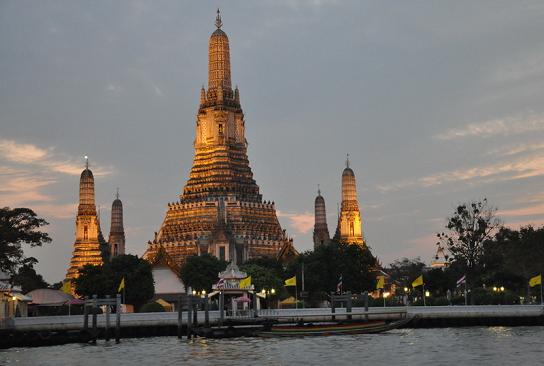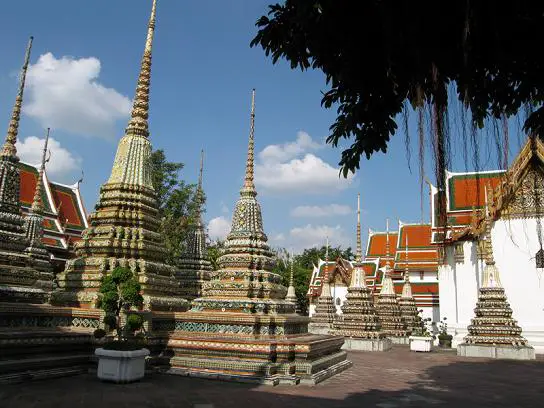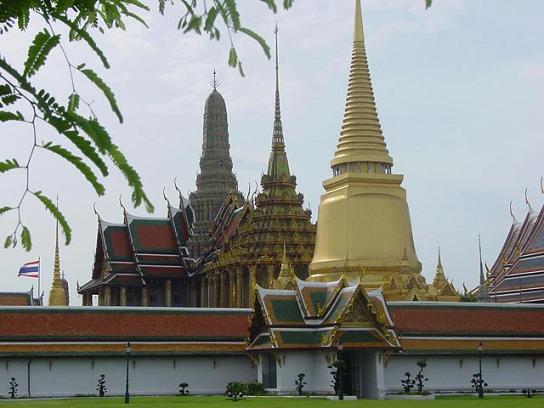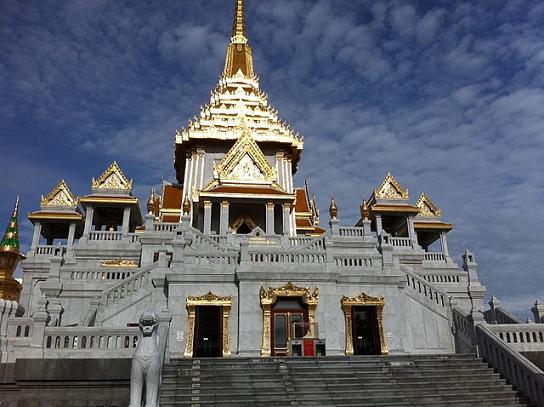
Although Wat Suthat is largely overlooked by many a tourist in Bangkok, it’s possibly a more interesting alternative to all the other touristy temples that seem to attract the biggest audience in the city. If you’d like to visit one of the least crowded places, then this one in this old part of the city may just be up your street.
I can never understand why so many tourists prefer to scramble over each other in a mad dash to visit the most popular temples in Bangkok when a much better time could be spent exploring some of the little lesser known temples in the city.
There are several options in which to choose, including this one here. Wat Suthat is considered Thailand’s sixth most important temple and what is of immense interest, this particular temple contains Bangkok’s tallest viharm as well as this temple being home to one of the largest surviving Sukhothai Bronze Buddhas.

Golden Buddha Figures
The construction of this temple began in 1807 by King Rama I and later completed by King Rama III. It was specially constructed to house the eight metres tall (26 foot) fourteenth century meditating Phra Sri Sakyamuni Buddha Statue. The Buddha was relocated from Wat Mahathat in Sukhothai to Bangkok by boat via the Chao Phraya River.
The bronze Buddha sits serenely inside an immense viharn surrounded by some of the most celebrated and well-preserved murals in Thailand. The walls are covered with scenes of the last 24 lives of the Buddha according to Buddhist Cosmology.
The columns show scenes of weird sea monsters and foreign ships said to be that of early westerners coming to Siam, as well as scenes depicting early life in Bangkok.

Art and Architecture
Art and architecture here show some beautiful examples the Rattanakosin style with the doors of the viharn in particular sporting some real wonders of Thai art. Carved into the doors are floral motifs and animals intertwined in jungle settings.
There are various accounts as to whether Rama III actually designed and carved the doors himself because immediately after completion, he ordered the chisels to be thrown into the river so that the fine carvings could not be reproduced.
The galleries that encircle the cloisters around the outside of the viharn are lined with 156 golden Buddha figures, many of which are continually being re-gilded. The outdoor compound between the Buddha Gallery and the Viharn is populated by pagodas and statues shipped in rice boats from China as ballasts.
The statues will amaze you and they include bronze horses, Chinese scholars and European sailors wearing goofy hats.
Sao Ching Cha (The Giant Swing)
Immediately in front of the temple is an enormous red Chinese gateway known as Sao Ching Cha. The Giant Swing was once a centrepiece of an annual ceremony honouring the Hindu god Shiva, but due to the high accident rate, the ceremonies are no longer held here, the last one being abolished in 1935.
A team of four men would attempt to swing in an 180-degree arc to gain enough momentum to catch a bag of gold tied to a pole about 25 metres (82 feet) in the air with their teeth.
Some say the very act of swinging was symbolic to that of the rising and setting of the sun, but others are quick to say that the ceremony was in fact based on yet another mystical legend. Don’t you just love these bizarre legends? Thailand does seem to have their fair share of them. Anyway, here is how the story goes.
The Hindu God Shiva and his consort Uma were banned from swinging in their heavenly abode because doing so caused cataclysmic floods on earth. This prompted Shiva to demand that the practice continues down on earth as a rite to ensure moderate rains and bountiful harvests. What on earth were they thinking! Well, that may be so in Thailand, but heavy floods today still cause violent upheavals in other parts of the world.


The Location
Wat Suthat is situated on Bamrung Muang Road not far from the Loha Prasat at Wat Ratchanada, the Democracy Monument and the Golden Mount. The grounds are open daily from 9:00 am until 9:00 pm with an entrance fee of just 20 Baht. It is best to take a taxi or private car to get here as public transport is limited.
The streets leading up to the temple and giant swing are the best places for browsing the shops should you be interested in religious paraphernalia. Thanon Bamrung Muang, in particular, is lined with shops selling everything a good Buddhist would ever need or a curious collector would ever want. That is to say from household offertory tables to temple umbrellas and big bold Buddha images.
You need to be aware that when investing in any sort of Thai collectable, there are some articles and artefacts that may not be allowed to leave the country. It would be best to discuss this with the seller before you make that purchase.
Also on offer are special alms packs which are sold mainly as donations to monks. A typical pack would consist of a plastic bucket containing the daily necessities such as soap, soap powder, toothpaste, toilet rolls, candles and incense sticks.
At one point in the road running alongside the Wat is a small Vishnu shrine, and a short way up another street is a larger shrine dedicated to the Hindu Trinity.











